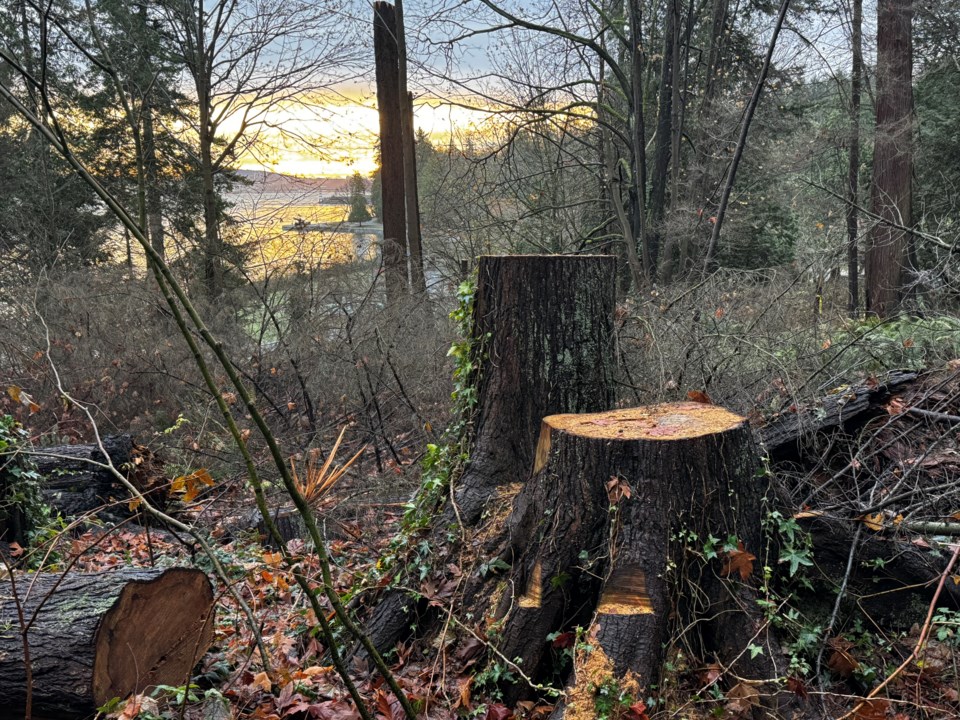The reports that justified spending millions of taxpayer dollars to cut down 160,000 trees in Stanley Park are hidden behind a paywall.
In October, the City of Vancouver awarded a $1.9-million emergency tree removal contract to a forestry consultant.
City council could rubber-stamp another $4.9 million of urgent spending when it meets Wednesday.
The Park Board claims up to a quarter of the trees in the park were killed by the Hemlock looper moth outbreak, but is refusing so far to show the science behind the logging program.
A reporter’s Nov. 22 application under the freedom of information law for copies of the arborist’s report, tree removal plan and tree inventory resulted in a $450 invoice.
The city’s Access to Information and Privacy Division said it required the fee because it claimed it needs 18 hours for “locating, retrieving and producing records, and preparing them for disclosure.”
Case manager Kevin Tuerlings said in a Dec. 20 email that he would contact the Park Board “to assess if there are documents related to your request that can be provided in under three hours in order to avoid a fee.”
Neither Tuerlings nor his manager, Cobi Falconer, have provided any update.
Falconer had earlier refused to release any of the records under the public interest paramount section of the law, which requires information be disclosed without delay if there is a risk of significant harm to the environment or safety of the public.
“I don’t know why they wouldn’t release information like that to the public,” said Norm Oberson, owner of Arbutus Tree Service and a member of the Trees of Vancouver Society board. “I think they're afraid that some qualified people get it, they look at it, and they go, ‘Oh, my God, what is this?'”
City arborist Joe McLeod did not respond.
Instead, he forwarded a reporter’s request to the communications department. Associate communications director Angela MacKenzie said “staff are unavailable for an interview.”
“They're really putting up barricades, to stop you from getting information, stop the public getting information,” Oberson said. “It really seems like a politically dysfunctional system.”
The civic communications department issued a news release on Nov. 29 about closures to major arterial routes to allow crews to take down trees.
Just a week later, the future of the Park Board became the focal point of civic news coverage before Christmas.
Mayor Ken Sim announced Dec. 6 that he would ask the BC NDP government to amend the Vancouver Charter and abolish the elected Park Board as a cost-saving measure. Three of ABC’s 2022-elected commissioners oppose Sim and now sit as independents.
On Jan. 24, city council will hear from a finance manager who filed a report dated Nov. 28 that recommends an urgent, one-time withdrawal of $4.9 million from the $80-million stabilization reserve.
Colin Knight’s three-page report said the funds would pay for cutting and restoration work at six Stanley Park sites totalling 86 hectares. In October, $1.9 million came from the Park Board to pay for B.A. Blackwell and Associates of North Vancouver for the latest phase of cutting.
Principal Bruce Blackwell did not respond for comment.
Knight’s report said the risk was identified in the 2024 budget, but a line item was not included “pending the development of an action plan and identification of funding sources.”
“Mitigation and restoration with extensive tree planting and vegetation management will need to take place from 2024 until 2026 and beyond,” Knight wrote.
It has been just over a year since the Park Board was originally briefed on the situation. McLeod and parks director Amit Gandha vowed at the Jan. 16, 2023, meeting to minimize tree-cutting.
“On one extreme, it's not really feasible to go and remove every single dead tree in Stanley Park, obviously for environment habitat reasons,” McLeod told the commissioners. “And we can't retain all of the dead trees as well for habitat. So we have to find that balance.”
Said Gandha: “As trees move into the forest, targets and issues are less likely, so we want to make sure that we plan accordingly. So part of it is coming up with a proper plan because there are some legacy trees, as the looper moth infestation continues to work through it, some of these trees are not dead. What we don't want to do is make mistakes in removing trees that will recover as well.”
On Oct. 20, Gandha provided a four-paragraph memo to update commissioners that said 25 percent of the trees greater than 20 centimetres in diameter had been killed or severely defoliated and an additional 36 percent had been moderately defoliated. Gandha also said the Musqueam Indian Band, 麻豆社国产Nation and Tsleil-Waututh Nation were “generally supportive of the risk mitigation work.”
Park Board chairman Brennan Bastyovanszky said it was an operational decision, which is why the matter did not come to a board meeting.
“They're following proper forestry practices and they're only removing dead trees,” Bastyovanszky said. “They're doing it because of the high risk of fire that having that much dead wood in the forest pushes the risk of fire alike to an unacceptable level.”
Oberson said forestry management must be conducted according to the assessment handbook published by BC Parks, WorkSafeBC and the Ministry of Forests. The Wildlife Act, Species at Risk Act and Identified Wildlife Management Strategy apply. He fears that the risk of wildfire is being overstated in order to expedite tree removal. That heightens the risk of errors and misidentification — cutting healthy trees.
“It’s a wild tree native park, it's an ecosystem that you want to protect and the dead trees are very valuable to the creatures that live in the park, birds and other insects and animals, etc., they’re an important part of the park,” Oberson said. “So usually you're trying not to remove them unless you have to mitigate risk.”




